This site contains affiliate links. As an Amazon Associate, I earn a commission from qualifying purchases at no extra cost to you. Full Disclosure Here.
About a month ago, I learned that it was possible not only to test old alkaline batteries to see if they are still are usable but also that, with the right type of charger, you can bring dead batteries back to life and that you can actually recharge alkaline batteries. To be quite honest, I was blown away.
Being a dutiful citizen of the world, when a flashlight, computer mouse or portable electronic gizmo such as a remote control stopped working, I dumped the old batteries into my recycle box and installed some new ones. Of course not being wasteful, I favored the use of rechargeable batteries and was quite proud of my collection of various sized Eneloop batteries which hold their charge for up to three years, even while sitting on the shelf.
First, a quick note on the “tools used” for this project:
- Cheap Battery Tester: Check this one out on Amazon.
- Universal Rapid Battery Charger: Check it out at this Amazon listing.
- Inexpensive Battery Storage Case: This is the one used in this tutorial.
A LADY ON A MISSION
Do you every get a bug in your bum and decide that nothing will stop you from the mission or task at hand? Well, that was me. I wanted to prove to myself that old alkaline batteries were still usable and further, as Dennis Evers (Preparedness is Fundamental) says, you can have free batteries for life.
The first thing I needed to do was to gather up the gear:
Old “dead” alkaline batteries
Battery tester simple enough to use without a Ph.D. in electronics
Battery charger designed specifically for alkaline batteries
Test gear such as flashlights, remote controls, wireless headphones and more
Simple enough although I did have to purchase the tester and the charge. But more on that later.
SORT THROUGH THE BATTERIES AND CULL THE DUDS
For years I have been saving all of my old batteries in a box in the garage, thinking that one of these days I would find someplace to recycle them. Where I live that is easier said than done so the box was pretty darn full which was great because that meant I had a lot of raw material to work with.
My Box of “Dead” Batteries
While waiting for my battery tester and alkaline charger to arrive, I sorted through the box, weeding out any leakers as well as odd ball batteries such as cell phone and hearing aid batteries. According to Wikipedia, the reason a battery leaks is this:
As batteries discharge — either through usage or gradual self-discharge — the chemistry of the cells changes and some hydrogen gas is generated. This out-gassing increases pressure in the battery. Eventually, the excess pressure either ruptures the insulating seals at the end of the battery, or the outer metal canister, or both. In addition, as the battery ages, its steel outer canister may gradually corrode or rust, which can further contribute to containment failure.
Leaked Battery – Yuck
Surprisingly, most of the batteries in my box were clean. Something to keep in mind as you go through the sorting process is that if there is even a single leaker in the box, the residue can spread on to other batteries so it helps to have a rag handy to wipe each battery off to see if it is okay. If you even suspect that a battery has leaked, or if shows any rust or corrosion, don’t take a chance. Throw the baddies back into the recycle box.
WHO SAYS THAT DEAD BATTERY IS REALLY DEAD?
I purchased an inexpensive battery tester from Amazon. There was nothing special about it and it was easy to use. Plus, it had the ability to test 9V batteries as well as button batteries and the traditional AA, AAA, C and D sized batteries.
Simple Battery Tester
I then set to work, testing each and every battery in my box. Much to my surprise, there were a number of batteries that tested “fully charged”. It is interesting to note that many were 9 Volt batteries that came out of one of my carbon monoxide detectors. This leads me to believe that the detector is bad and not the batteries.
Furthermore, I now believe that what commonly happens is that, for example, a remote control or flashlight is dead. You dump the batteries into the recycle box and install new ones. Easy peasy. But in truth, perhaps only a single battery of the 2 or 3 are bad so in effect, you are dumping out 1 discharged battery and 2 or 3 perfectly usable batteries. I even proved this myself. Since I now keep one of these $8 testers in my desk drawer, when my wireless mouse died a couple of days ago, I found that only one of the two AAA batteries that I had removed was dead. The other was showing almost a full charge. Go figure.
The other thing, and something that makes me feel careless and stupid, there were some perfectly good rechargeable batteries in the box. Now, how the heck did that happen?
These were good!
And I thought these batteries were dead.
LET THE RECHARGING BEGIN
After reading reviews on various rechargers, I settled on the Maximal Power FC999 Universal Battery Charger. It wasn’t the most expensive available but according to a couple of the reviewers, this unit was exactly the same as a higher priced model. The difference was that this one is black and the other one was gray.
Maximal Power FC999 Universal Battery
Now here is the deal with this charger. It has four separate charging chambers that operate independently of each other. This means that you can mix and match battery sizes (AA, AAA, C, D) without a problem. It also has a center 9V battery chamber but I have not been able to figure out whether that piggybacks upon one of the adjacent chambers or whether it operates separately.
Note: this charger can also be used to charge Ni-cd and Ni-MH batteries but I only tested it on Alkaline batteries. There is a slider switch that allows you to select the type of batteries you are charging – they can not and should not be mixed and matched by type (although, as I mentioned, various sizes of the same type work just fine.)
There is no question that I experienced a bit of trepidation when I inserted the batteries into the charger for the first time. But there was no smoke and no explosion so I continued on.
A few seconds after you insert the batteries, the tester will recognize the status and the LED window will either say “CHA” (for charging) or “BAD” (for sorry, this is a bad battery and it cannot be charged). In addition, the following lights will glow:
- Red – Charging
- Green – Fully Charged
- Red Flashing – BAD
As I mentioned above, each of the four chambers operates independently so you could have a combination of these three options all going at once.
There is a chart in the manual that indicates that an AAA battery will take 2.5 hours to charge, an AA 5 hours, a C size 6 hours, and a D sized 10 hours. In my experience, however, they charge to the fully-charged, green light stage a lot sooner than that. Now here is the thing. Once fully charged, the charger switches to a trickle charge to keep the battery “at its optimum capacity” whatever that means.
My experience is that if you leave the recharged batteries in the charger overnight – or say for about 10 or 12 hours – you will get a much stronger charge. I say this because I first tested some batteries right after the green light came on. On my tester, they would register at about the half way mark in the fully-charged area. If I put them back in the charger, the green fully-charged light would come on right away but when I took them out the next morning, the tester showed them about 90% charged.
These batteries have been re-charged and are now usable
After doing this a few times, I realized that next on my bucket list was a tester that would give me the actual voltage of the re-charged battery. My brother and nephew – both electronics wizards – have one and tell me that is the only way to truly test the remaining juice left in a used battery.
OTHER TESTING NOTES
The little manual that came with the charger stated that alkaline batteries can be charged to 75 – 90% of their original capacity. It further said that the batteries should be fully drained before recharging but I found that as a practical matter, the fully drained batteries came up “BAD” and could not be recharged at all.
There is one more rather important note that I want to make. I checked on my recharged batteries about two weeks after storing them in a box in my utility cupboard. Much to my surprise, there were some new leakers. Now whether these were overlooked initially (had I wiped away the residue not realizing they were compromised) or a byproduct of the charging process – I do not know. Even more curious, they were all the Costco Kirkland brand batteries.
I had good luck charging the Duracell batteries
The manual also indicates that alkaline batteries should not be recharged more than 30 times. 30 times – holy moly – that seems like a lot of charging to me. For now, I will charge them once until I go through the pile and then start anew. But 30 times? I am going to play it safe and protect my devices by recharging no more than a dozen times if that.
SO REALLY, HOW DID THEY WORK?
Using the recharged batteries on low power devices such as mini LED flashlights and of course, my computer mouse, worked great. As a matter of fact, I can not tell the difference between the recharged Alkalines and standard rechargeables. On the other hand, the Survival Husband uses wireless headphones to watch TV and the recharged alkalines only last abut 8 hours as opposed to the typical 15 to 20 hours with standard Ni-mh rechargeables.
Flameless candles have burned steadily for 5 days
The recharged 9V battery worked especially well on my little Blocklite flashlight. This little flashlight has been on 24/7 since March 9th and today for the first time I noticed the LEDs starting to fade when all six LEDs are on. When I turn the switch to 2 LED mod, it is as bright as ever.
Blocklite Mini Flashlight in Day 7
Clearly, for now, at least, it appears that the recharged alkaline batteries are best suited for low-drain devices.
STORING THE BATTERIES
I purchased these inexpensive storage cases for my recharged batteries. They are really quite handy and I like that the six individual cases interlock and connect together to make a larger case. The rest of my spares are in the plastic pencil case you see pictured above.
I like these mini storage cases.
THE FINAL WORD
For a total investment of about $34, I now have what for all intents and purposes, a lifetime of free batteries. The reason I say “lifetime” is that my friends have indicated a willingness to give me all of their dead batteries and you can bet that many will still be either good as is or eligible for recharging.
Would I trust these recycled batteries in a survival situation – sure, if that is all I had, But of course, that is not the case. I still have a large supply of brand new alkaline batteries in all sizes plus a good supply of standard rechargeables (you know how I love those Eneloop rechargeables).
But as spare batteries to use day to day, heck, these are great. As my tests have proven, a recharged alkaline battery can keep a small LED flashlight going to over a week and a computer mouse for much longer than that. As a matter of fact, you might say I have become obsessed with using these recharged alkaline batteries. But that, of course, is a story for another time.
Additional Resource: If you also want to create the ultimate battery charging batteries with different power sources and methods, check out this resource on the best charging set-ups.
Bargain Bin: Here are links to the products mentioned in today’s article. I do hope you will consider the battery tester – it will definitely pay for itself by preventing you from recycling perfectly usable alkaline batteries.
Maximal Power FC999 Universal Battery Charger: This nicely built charger will charge AA, AAA, C, D, N, 9V, Ni-MH, Ni-CD, and Alkaline batteries. It has an LED display so that when you first put a battery in the charging bay, you know whether it is viable for charging or simply bad and ready to go back to the recycle box. Note: When I purchased the charger, it was on back order. Oddly, it actually shipped the next day. Go figure. Anyway, I am really sold on this charger and can recommend it without reservation.
Blocklite Mini Compact Size Ultra Bright 9V LED Flashlight: One of my readers (James) turned me on to these nifty little LED flashlights. They were great with re-charged 9V batteries. There is a similar flashlight called the Pak-Lite (which is more expensive) but it does not have a high-low switch like this one.
SE BT20 9-Volt Battery Tester You definitely should consider a battery tester even if you decide not to re-charge your alkalines. The advantage of having a tester is that when a gizmo dies, you can determine whether just a single battery is discharged and not the complete set.
SODIAL(TM) Battery Tester Volt Checker for 9V 1.5V and AA AAA Cell Batteries: This tester has a numeric display – something worth considering although may take two to three weeks to arrive.
AA / AAA 4 Cell Battery Storage Case (Bundle of Six Cases): I like these little cases. I put a sticker on the outside of the case indicating that these are re-charged batteries.
And for traditional rechargeable batteries:
Solar 11-in-1 Battery Charger: This is a universal charger that does what it is supposed to do. It uses sunlight to generate a current that charges pairs of batteries in sizes AAA, AA, C, or D and works great with my favorite Eneloop batteries.
Sanyo Eneloop 1500 Super Power Pack: This kit has it all, including 12 AA, 4 AAA, 2 C and D Spacers, a 4 position charger and storage case. This is the kit that I own.
~~~~~


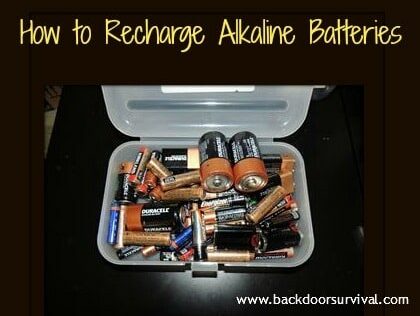

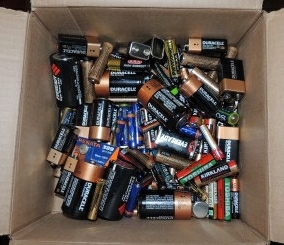
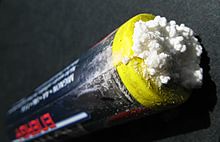
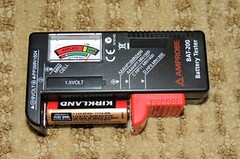
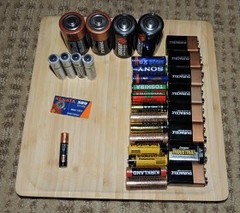

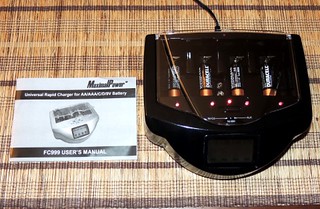
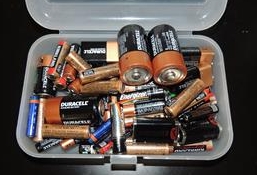
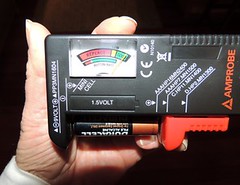




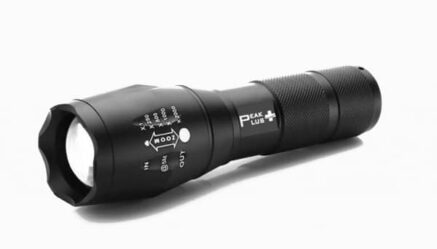






139 Responses to “How to Recharge Alkaline Batteries”
I have a bunch of yard lights purchased years ago. They
are solar powered and eventually the NiCad batteries in them
died. I was given a sack full of Costco AA batteries that came
out of wireless Microphones which get used for several church
services then replaced every week as they do not want failures
during a church service. I put those batteries (kirkland) brand
in my solar lights and they lasted months to a year … running
all night and charging all day … not 10 times nor 30 times but
hundreds of times. I got a free meter from Harbor Freight – it in
in their ads regularly – actually I have one in every vehicle.
I sort my free batteries by voltage I am not convinced that this is
a good test and at a yard sale I bout a little VOM (volt ohm meter)
for a $1 US that had a special battery test scale. I think that
this actually puts a load on the battery. 50 years ago when I worked
on Pilot’s emergency radios and their batteries, I load tested batteries for a specific period of time and then checked the voltages. Low batteries were replaced. We would not want our nation’s defenders out flying around without good emergency equipment.
I have not had a problem with Kirkland batteries leaking. Many years ago I lived in Portland and I had a source of no cad batteries from
a warranty repair shop I discovered that those dead C cells in power packs often came back to life if zapped with a jumper cable hooked up
to a 12 volt battery. It was also almost like an instant charge. Batteries that would not charge in a charger often worked perfect after one or more zaps with a jumper cable hooked up to a 12 volt car battery. Even now I gather recycled batteries from recycle bins and
recharge them and it has given me many spares for my power tools for free. Ones that do not recharge get an x marked on them and I return them to the recycle box. Free is a very good price for an old man living on Social Security $$$.
Just a bit more info, I was making chargers 20 years ago to charge Duracell batteries, the key to stop them overheating and exploding was for every mA put into the battery you had to remove a tenth of it,
We did this in the UK by using an AC 50hz transformer a Diode and 2 resisters
Resistors on the plus wave it loaded 200mA and on negative cycle removed 20mA, this method I was able to charge my Casio TV back up as quick as it drained.
|—|>—-|
|–[==]–|–[==]–|
Crude diagram
Cute. There is always a sweet spot. I wonder how many cycles they can go through before they finally bite the dust, though.
Thank you for reposting this. It was something that I’ve tried to find a reliable reference for – which item performs best based on someone I trust – and you provided that. Just used your links to purchase all three. Love your site and appreciate all the time and effort you put into giving us such good information.
Throwing batteries into a box or bag, etc., may set your house on fire. It has happened. 9 volt batteries are particularly dangerous as the terminals are close together. Shorting the terminals may cause a fire, even if the battery is pretty well discharged.
2 Simple ways to recharge batteries.
1) Over night
Fill up a hot water bottle “Yes with hot water” fold it in half with the batteries in the middle of the fold, wrap it up tight in a quilt and leave overnight. FULLY CHARGED.
2) 5 Min fix
boil a cup of hot water, place batteries in a mug or cup, get a plastic bag with no holes and place in the mug poor hot water in the bag. Charged Batteries.
This works 100% just allways check Batteries are not leaking, Iv’e never had any leaks in years of doing this but saftey1st.
This does not work….possible batteries may heat up and explode or leak plz do not try this thx
I don’t see why it wouldn’t work, you heat the battery by charging it the normal way (With a power supply to charge it +-) which gives it a charge, heating up the chemicals that are inside the battery, storing the energy. It will heat the particles in it doing it this way also, you just need to be careful how hot the water is, it’s just like how much current and volts you are putting through it with the normal DC charge, experiment, but take the necessary safety precautions, that’s the only way to find out.
Another idea would be putting them\it in a flask to contain the heat and this provides extra safety if they\it were to explode.
i spent 10 years of my life in various prisons, in one state you were only allowed an AM radio purchased from the prison store and it ran on D size batteries. we used several methods to recharge batteries so you did not have to buy new ones from the prison store.
first of place several dead batteries in a sock, then swing the sock really hard to make contact with your enemies face, didnt recharge the batteries but the enemy always went to the hospital.
but seriously, we would place the batteries near a heat source, even the heat above a floresent light fixture would bring them back to life, not 100% capacity but recharged and saving money just the same.
another way we hacked batteries was to connect them in series or parallel or even both at the same time to create a battery pack. a bunch of week batteries make 1 kinda ok battery.
check thrift stores for battery pack holders. “madela” breast pumps sometimes have a battery holder that holds 8 AA batteries to make a 12 volt power source with a plug coming out of it. or you can make your own holder with just some tape and wire.
the whole jest of the article was that you throw away useable batteries every day. a penny saved is most definately a penny. if you use solar to charge then you have only a 1 time cost. throwing away batteries and buying new ones is built in job security for the retailer. why give your hard earned money away if you do not have to.
everyone, put your hands in the air, i might have a gun in my pocket and i might not be affraid to use it. now empty the money in your wallets into an envelope and place a stamp of it, then contact me and ill tell you where to send it so it reaches me.
see how silly it would be to let me rob you of hard earned money? but you do the same thing every day, by forking over hard earned money in exchange for a product that you are going to throw out shortly.
Costco batteries are the WORST. I had one explode in my fluke tester, and I had to clean it, and
glue it back together.
My 2 cents worth regarding dead batteries appearing not to be dead when checked a while later – Many years ago we were investigating why our new low power parking meter design was actually using a lot less power, but the batteries were not lasting as long as in the older higher power design. After much research we discovered that the pin running from the negative terminal down the inside of the battery appeared to oxidise when there was not enough current being drawn through it. By simply ‘knocking’ the batteries we were able to brake the oxidation layer and the batteries where good for another few months. So there is merit to ‘banging’ your torch when it is dim or putting batteries in the sun to get another life out of them. We never explored the actual science behind the discovery and needless to say the big battery corporations didn’t bother responding when we enquired, so we changed to LiFePO4 rechargeables. So those ‘dead’ batteries are very often only ‘dormant’ and a good knock will ‘wake’ them up.
Hendrik – What a fascinating bit of information. I plan to give the “knocking” trick a go the next time my batteries test good but are not functional. I find this happens with one of my carbon monoxide detectors a lot which makes me think the unit and not the batteries are bad.
Is that like hitting your fruit tree with a bat several times as hard as you can to “wake it up?” I know it sounds strange but we had a pear tree that wasn’t producing fruit for several years and did this. The next year had fruit.
Sorry, I know this isn’t about batteries, but it is about “recharging.”
Ok, maybe I should be “hit” to get recharged. Hhhaaaaa….
Hello great thread with a few paranoid types chipping in LOL ..heres my c cents worth …I us a wireless tail tight set up that requires 4 AA on each Led light ..I went out and bought expensive Nicad energizer batterys the other day and they wont power the lights…why ? heres why Nicad rechargeable only supply 1.2 volts …alkaline toss outs make 1.5 ..I ntend to recharge some as the article tell you how too …NO FEAR …thanks Gaye !!
I only use alkalines for remotes and clocks/timers. Everything else gets rechargeables (yes, Eneloops).
Gaye
Great post. Commendable research on your part.
I just replaced 12 AA batteries tonight in my 6 electronic candles on the family room fireplace mantel. Have to do that every 6 or 8 months or so.
Also replaced 4 C batteries in my wife’s bedside combination flashlight, florescent light, flashing light and radio. This item rarely used, an emergency device, but needs batteries at least annually. I’m really considering the purchase of the FCC Maximal Power FC999 Universal Battery Charger.
And then I read Joe’s comments on June 6,14. Being an EE myself, I know he is on target regarding safety. Those without knowledge of the risk involved by deviating from manufacturer’s recommendations for use/handling of electronic devices should not “do this at home”. My suggestion would be to go ahead with your suggestions on recharging batteries. But be careful not to disregard Joe’s comments with regard to safety. Get professional help if in doubt!
Thanks
Don